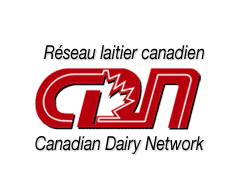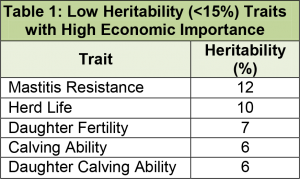 “I just manage for those things”, or “It takes too long to improve those traits,” or “Selecting for those traits won’t lead to any real difference in my herd”. Have any of these thoughts crossed your mind when considering low heritability traits? We often encounter comments such as these and would like to set the record straight – selection for low heritability traits does make a difference in female performance and will affect your bottom line.
“I just manage for those things”, or “It takes too long to improve those traits,” or “Selecting for those traits won’t lead to any real difference in my herd”. Have any of these thoughts crossed your mind when considering low heritability traits? We often encounter comments such as these and would like to set the record straight – selection for low heritability traits does make a difference in female performance and will affect your bottom line.
Heritability – The Highs and Lows
 Simply put, heritability is the amount of total variation for a trait in a population that can be attributed to genetics. For example, the heritability of protein yield is high at 40%. Imagine two cows in two different herds that each have a different protein yield. Around 40% of the difference in their protein yields can be explained by genetics and the other 60% of the difference is due to herd management and environment. Protein yield is a win-win trait – it is of high economic importance and also has a moderately high heritability.
Simply put, heritability is the amount of total variation for a trait in a population that can be attributed to genetics. For example, the heritability of protein yield is high at 40%. Imagine two cows in two different herds that each have a different protein yield. Around 40% of the difference in their protein yields can be explained by genetics and the other 60% of the difference is due to herd management and environment. Protein yield is a win-win trait – it is of high economic importance and also has a moderately high heritability.
Similar to protein yield, traits associated with health, fertility and longevity are of great economic importance. However, unlike yield traits, these traits are lowly heritable because they are complex, making them difficult to define, record and evaluate. Traits with a heritability below 15% (Table 1) are, therefore, strongly influenced by environmental effects and require attention in terms of herd management in order to reach optimal levels.
Take Daughter Fertility, for instance, which has a heritability of 7%. On average, 93% of all factors influencing a given cow’s reproductive performance are non-genetic. Since environment and herd management are so impactful when it comes to Daughter Fertility, does this mean it should only be managed for and ignored genetically? Absolutely not! While heritability tells us how closely genetic merit follows phenotypic performance, it tells us nothing about the economic value of better performance.
Selection for Low Heritability Traits Makes a Difference
To show that selection for low heritability traits can result in improvement, Canadian Dairy Network (CDN) examined the performance of daughters of the five highest and lowest sires for Daughter Fertility and Herd Life that had over 1000 daughters in their proofs. It’s important to note that these aren’t sires that just happened to be good for the traits we’re interested in, these are progeny proven sires that were returned to active service, most likely based on their LPI, and became popular for various reasons and heavily used in Canada.
Table 1 shows the average daughter performance for sires that excel or are poor for Herd Life based on actual survival data for at least 1000 daughters. The top five sires averaged 109 for Herd Life, while the bottom five sires averaged 93 (breed average is 100). Daughters of the top five sires for Herd Life had a greater average number of calvings, a longer productive life, and had higher survival rates to later lactations compared to daughters of the bottom five sires. This is especially evident when looking at the survival rates to 3rd and 4th calving, where sires that excel for Herd Life had approximately 20% more daughters still alive to start their 3rd and 4th lactation relative to sires that were poor for Herd Life. For a producer, this translates into more profitability and the option to have fewer herd replacements.
Table 1: Average Daughter Performance for the Top 5 and Bottom 5 Sires for Herd Life with Greater than 1000 Daughters

Table 2 shows the average daughter performance for sires that are high end or inferior for Daughter Fertility based on actual reproductive data for at least 1000 daughters. The top 5 sires had a proof that averaged 19 points higher for Daughter Fertility than the bottom 5 sires. Milking daughters of top sires required 13% fewer inseminations per conception and averaged 10 fewer days open. Research suggests the cost of each extra day open is approximately $4. Based on this estimate, the genetic disadvantages alone of a daughter of a bottom end sire for Daughter Fertility translates to an opportunity cost of $40 per female.
Table 2: Average Daughter Performance for the Top 5 and Bottom 5 Sires for Daughter Fertility with Greater than 1000 Daughters

Daughters of the sires in the two examples above are found across Canada, in a wide variety of management systems and environments. The performance differences seen between the top and bottom groups can be attributed exclusively to genetics. Despite the low heritability of Herd Life and Daughter Fertility, using sires that excelled (or were poor) for these traits resulted in notable differences in daughter performance. These examples prove that low heritability traits can make a difference. Genetic evaluations for this category of traits help to identify the extreme sires on each end of the spectrum. When it comes to determining which traits are included in your breeding goals, turn to economic importance before heritability – your bottom line will thank you for it.
Authors: Lynsay Beavers and Brian Van Doormaal, Canadian Dairy Network
Date: July 2014









